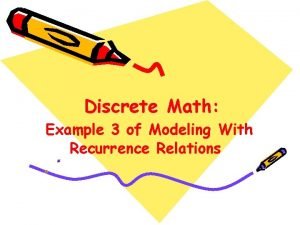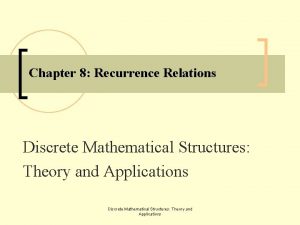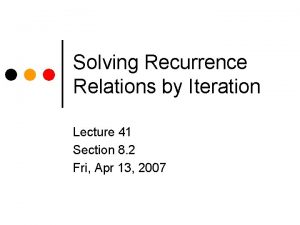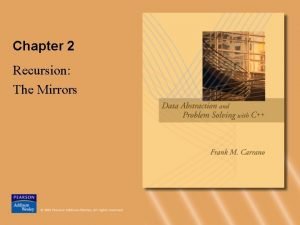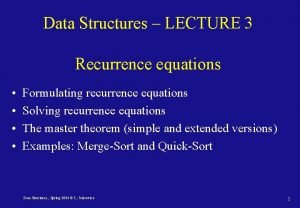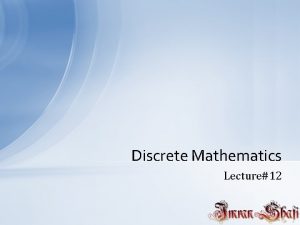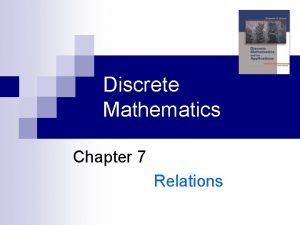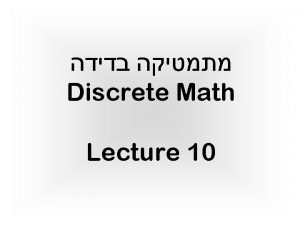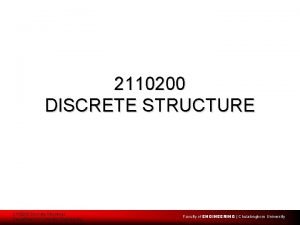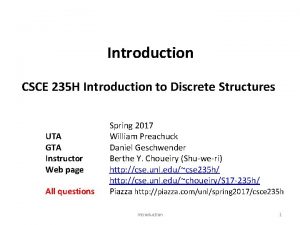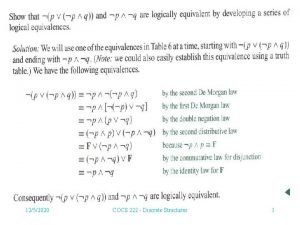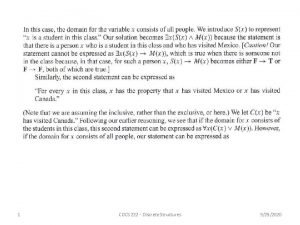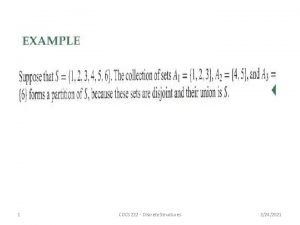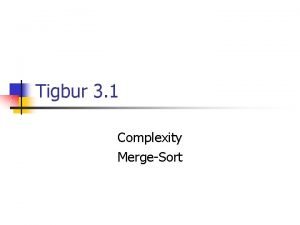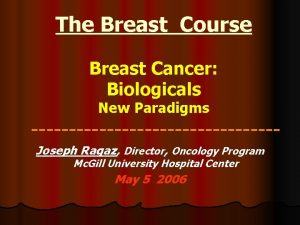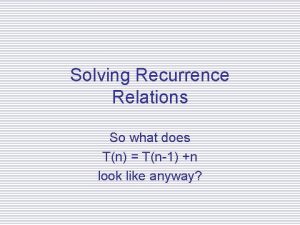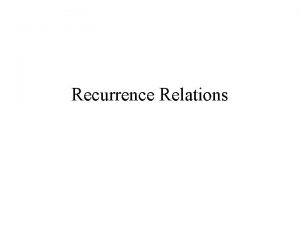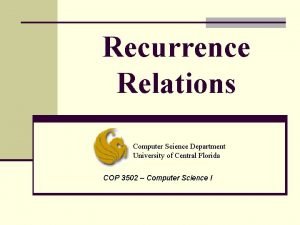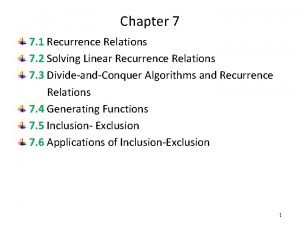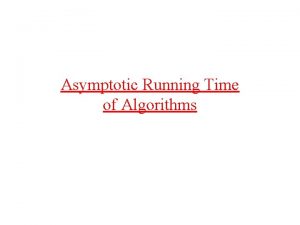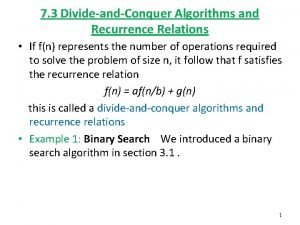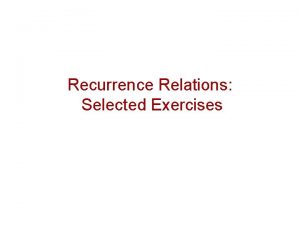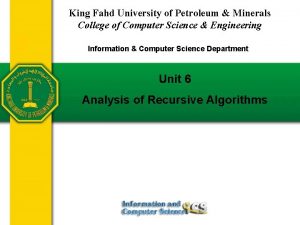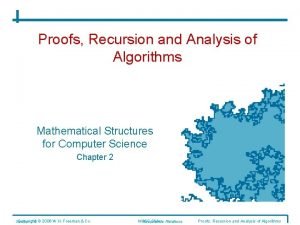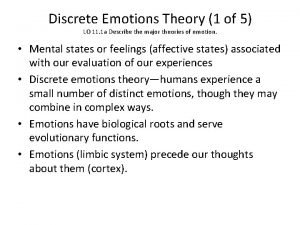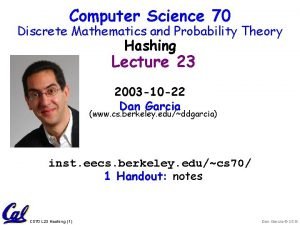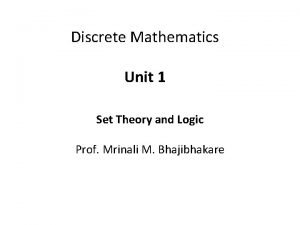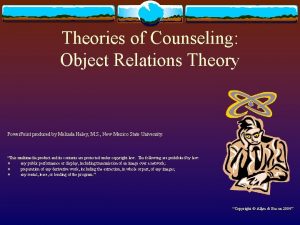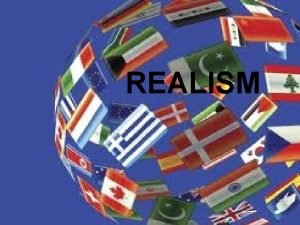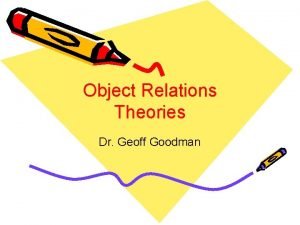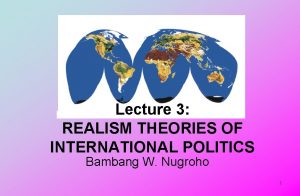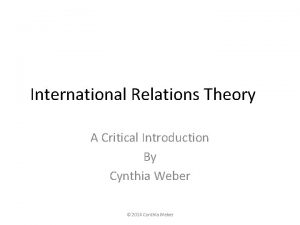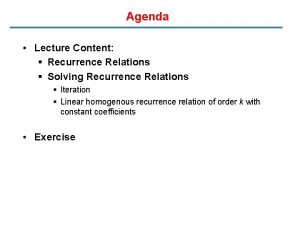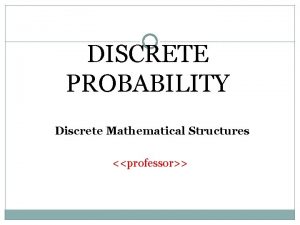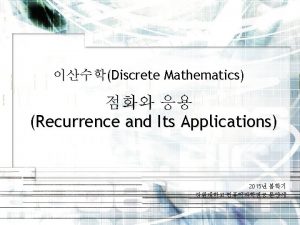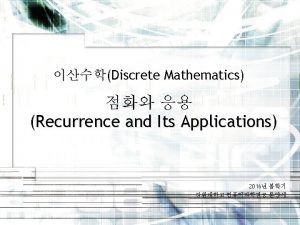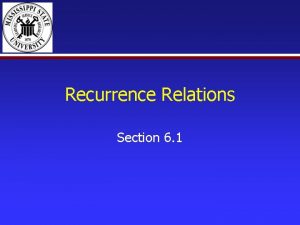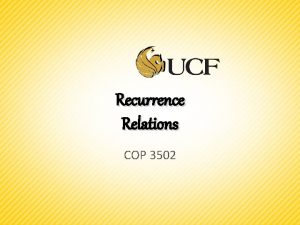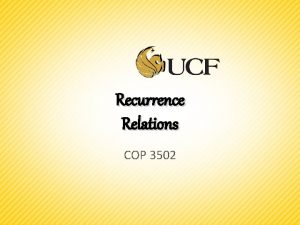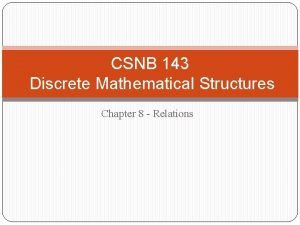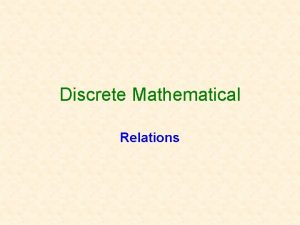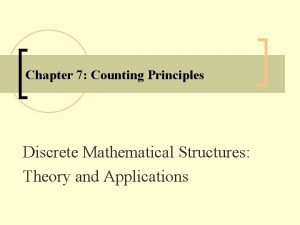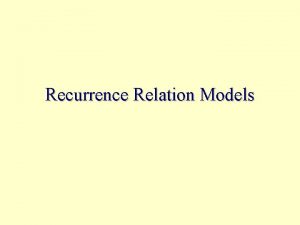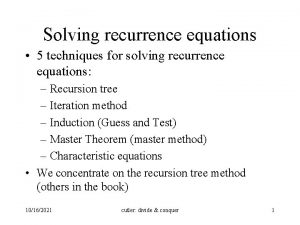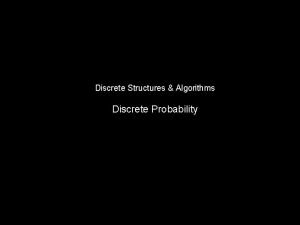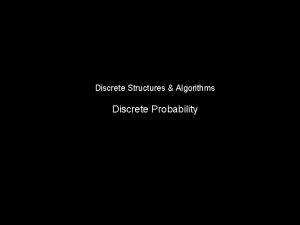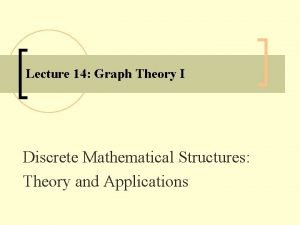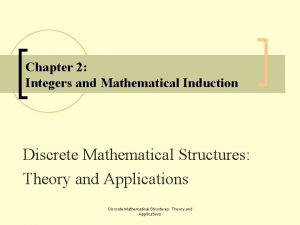Chapter 8 Recurrence Relations Discrete Mathematical Structures Theory












































- Slides: 44

Chapter 8: Recurrence Relations Discrete Mathematical Structures: Theory and Applications

Learning Objectives q Learn about recurrence relations q Learn the relationship between sequences and recurrence relations q Explore how to solve recurrence relations by iteration q Learn about linear homogeneous recurrence relations and how to solve them q Become familiar with linear nonhomogeneous recurrence relations Discrete Mathematical Structures: Theory and Applications 2

Sequences and Recurrence Relations Discrete Mathematical Structures: Theory and Applications 3

Sequences and Recurrence Relations Discrete Mathematical Structures: Theory and Applications 4

Sequences and Recurrence Relations Discrete Mathematical Structures: Theory and Applications 5

Sequences and Recurrence Relations Discrete Mathematical Structures: Theory and Applications 6

Sequences and Recurrence Relations Discrete Mathematical Structures: Theory and Applications 7

Sequences and Recurrence Relations Discrete Mathematical Structures: Theory and Applications 8

Sequences and Recurrence Relations Discrete Mathematical Structures: Theory and Applications 9

Sequences and Recurrence Relations q Tower of Hanoi q In the nineteenth century, a game called the Tower of Hanoi became popular in Europe. This game represents work that is under way in the temple of Brahma. q There are three pegs, with one peg containing 64 golden disks. Each golden disk is slightly smaller than the disk below it. q The task is to move all 64 disks from the first peg to the third peg. Discrete Mathematical Structures: Theory and Applications 10

Sequences and Recurrence Relations q q The rules for moving the disks are as follows: 1. Only one disk can be moved at a time. 2. The removed disk must be placed on one of the pegs. 3. A larger disk cannot be placed on top of a smaller disk. The objective is to determine the minimum number of moves required to transfer the disks from the first peg to the third peg. Discrete Mathematical Structures: Theory and Applications 11

Sequences and Recurrence Relations q First consider the case in which the first peg contains only one disk. q The disk can be moved directly from peg 1 to peg 3. q Consider the case in which the first peg contains two disks. q First move the first disk from peg 1 to peg 2. q Then move the second disk from peg 1 to peg 3. q Finally, move the first disk from peg 2 to peg 3. Discrete Mathematical Structures: Theory and Applications 12

Sequences and Recurrence Relations q Consider the case in which the first peg contains three disks and then generalize this to the case of 64 disks (in fact, to an arbitrary number of disks). q Suppose that peg 1 contains three disks. To move disk number 3 to peg 3, the top two disks must first be moved to peg 2. Disk number 3 can then be moved from peg 1 to peg 3. To move the top two disks from peg 2 to peg 3, use the same strategy as before. This time use peg 1 as the intermediate peg. q Figure 8. 2 shows a solution to the Tower of Hanoi problem with three disks. Discrete Mathematical Structures: Theory and Applications 13

Discrete Mathematical Structures: Theory and Applications 14

q Generalize this problem to the case of 64 disks. To begin, the first peg contains all 64 disks. Disk number 64 cannot be moved from peg 1 to peg 3 unless the top 63 disks are on the second peg. So first move the top 63 disks from peg 1 to peg 2, and then move disk number 64 from peg 1 to peg 3. Now the top 63 disks are all on peg 2. q To move disk number 63 from peg 2 to peg 3, first move the top 62 disks from peg 2 to peg 1, and then move disk number 63 from peg 2 to peg 3. To move the remaining 62 disks, follow a similar procedure. q In general, let peg 1 contain n ≥ 1 disks. 1. Move the top n − 1 disks from peg 1 to peg 2 using peg 3 as the intermediate peg. 2. Move disk number n from peg 1 to peg 3. 3. Move the top n − 1 disks from peg 2 to peg 3 using peg 1 as the intermediate peg. Discrete Mathematical Structures: Theory and Applications 15

Sequences and Recurrence Relations Discrete Mathematical Structures: Theory and Applications 16

Sequences and Recurrence Relations Discrete Mathematical Structures: Theory and Applications 17

Discrete Mathematical Structures: Theory and Applications 18

Linear Homogenous Recurrence Relations Discrete Mathematical Structures: Theory and Applications 19

Linear Homogenous Recurrence Relations Discrete Mathematical Structures: Theory and Applications 20

Linear Homogenous Recurrence Relations Discrete Mathematical Structures: Theory and Applications 21

Linear Homogenous Recurrence Relations Discrete Mathematical Structures: Theory and Applications 22

Linear Homogenous Recurrence Relations Discrete Mathematical Structures: Theory and Applications 23

Linear Homogenous Recurrence Relations Discrete Mathematical Structures: Theory and Applications 24

Discrete Mathematical Structures: Theory and Applications 25

Discrete Mathematical Structures: Theory and Applications 26

Linear Homogenous Recurrence Relations Discrete Mathematical Structures: Theory and Applications 27

Discrete Mathematical Structures: Theory and Applications 28

Discrete Mathematical Structures: Theory and Applications 29

Linear Homogenous Recurrence Relations Discrete Mathematical Structures: Theory and Applications 30

Linear Homogenous Recurrence Relations Discrete Mathematical Structures: Theory and Applications 31

Linear Homogenous Recurrence Relations Discrete Mathematical Structures: Theory and Applications 32

Linear Homogenous Recurrence Relations Discrete Mathematical Structures: Theory and Applications 33

Linear Nonhomogenous Recurrence Relations Discrete Mathematical Structures: Theory and Applications 34

Linear Nonhomogenous Recurrence Relations Discrete Mathematical Structures: Theory and Applications 35

Linear Nonhomogenous Recurrence Relations Discrete Mathematical Structures: Theory and Applications 36

Linear Nonhomogenous Recurrence Relations Discrete Mathematical Structures: Theory and Applications 37

Discrete Mathematical Structures: Theory and Applications 38

Linear Nonhomogenous Recurrence Relations Discrete Mathematical Structures: Theory and Applications 39

Linear Nonhomogenous Recurrence Relations Discrete Mathematical Structures: Theory and Applications 40

Discrete Mathematical Structures: Theory and Applications 41

Discrete Mathematical Structures: Theory and Applications 42

Linear Nonhomogenous Recurrence Relations Discrete Mathematical Structures: Theory and Applications 43

q Remark 8. 3. 14 q There are two ways to solve a linear nonhomogeneous equation of the form with some given initial conditions. 1. First find a particular solution and then add the particular solution to a solution of the associated linear homogeneous recurrence relation. 2. First obtain a linear homogeneous recurrence relation from the given linear nonhomogeneous recurrence relation, as shown in this section. Then a solution of the given linear nonhomogeneous recurrence relation is also a solution of the linear homogeneous equation obtained. Next find a solution of the homogeneous recurrence relation and use the initial conditions of the nonhomogeneous recurrence solution to find the constants. Finally, verify that the solution obtained satisfies the linear nonhomogeneous recurrence relation. Discrete Mathematical Structures: Theory and Applications 44
 Recurrence discrete math
Recurrence discrete math Recurrence relation in discrete mathematics
Recurrence relation in discrete mathematics Solve for a
Solve for a Solving linear homogeneous recurrence relations
Solving linear homogeneous recurrence relations Common recurrence relations
Common recurrence relations Rabbits and recurrence relations
Rabbits and recurrence relations Advanced counting techniques
Advanced counting techniques Recurrence data structures
Recurrence data structures Mathematical economics vs non mathematical economics
Mathematical economics vs non mathematical economics Reflexive relation examples
Reflexive relation examples Relations and digraphs in discrete mathematics
Relations and digraphs in discrete mathematics Binary relation examples
Binary relation examples Mathematics 1
Mathematics 1 Discrete structures
Discrete structures Discrete math
Discrete math Discrete computational structures
Discrete computational structures Discrete structures
Discrete structures Cs 584
Cs 584 Discrete structures
Discrete structures Employee relations in public relations
Employee relations in public relations Homologous structures examples
Homologous structures examples Recurrence relation merge sort
Recurrence relation merge sort Recurrence rate
Recurrence rate Recurrence relation for linear search
Recurrence relation for linear search Master theorem
Master theorem Recurrence relation computer science
Recurrence relation computer science Hsv-2 oral transmission rates
Hsv-2 oral transmission rates Recurrence relation
Recurrence relation Asymptotic cheat sheet
Asymptotic cheat sheet Algorithm recurrence relation
Algorithm recurrence relation Unrolling the recurrence
Unrolling the recurrence Recurrence relation exercises
Recurrence relation exercises Recurrence relation of recursive selection sort
Recurrence relation of recursive selection sort What is recurrence equation
What is recurrence equation Discrete theory of emotion
Discrete theory of emotion Computer science 70
Computer science 70 Sets and propositions in discrete mathematics
Sets and propositions in discrete mathematics Object relations theory - ppt
Object relations theory - ppt Nature of realism
Nature of realism Human relations theory of management
Human relations theory of management Object relations
Object relations Realist theory of international relations
Realist theory of international relations Realist theory of international relations
Realist theory of international relations Cynthia weber international relations theory
Cynthia weber international relations theory Interpersonal relations theory by hildegard peplau
Interpersonal relations theory by hildegard peplau
